Top Surf Lessons in Malibu for All Skill Levels
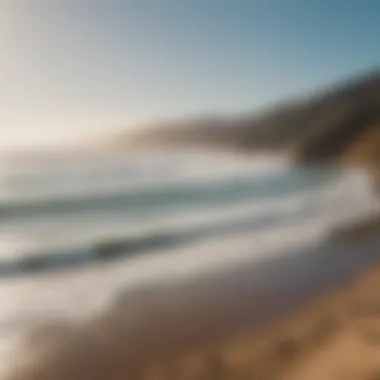

Intro
Surfing is not just a sport; it’s a lifestyle that captures the spirit of adventure and the essence of the ocean. Malibu, with its sun-kissed beaches and consistent waves, offers an ideal backdrop for both newcomers and seasoned surfers alike. With various surf schools and instructors dotting the coastline, the choices can be overwhelming. This article serves as a compass, guiding you through the intricate landscape of surf lessons available in Malibu. Whether you’re casting your first glance at the sea or carving waves like a pro, there’s a lesson suited just for you.
In the following sections, we will unpack essential techniques for beginners, dive into advanced skills for more experienced surfers, and explore the gear that can make all the difference in mastering the waves. Plus, we will offer insights on how to choose the right lessons tailored to your individual needs, ensuring that safety and enjoyment become an integral part of your surf journey.
Techniques and Skills
Essential Techniques for Beginners
For those taking their first steps into surfing, understanding a few foundational techniques can greatly enhance the learning experience. Initially, balancing on the board is crucial. Start on dry land practicing getting up from a lying position to your feet in one smooth motion. This technique, known as the "pop-up," is a fundamental skill every beginner must conquer.
Once you’re comfortable popping up, you’ll want to learn how to position yourself on the board. Staying forward helps maintain balance and allows you to ride the waves more effectively. It’s also important to understand the mechanics of paddling. Proper paddling technique not only gets you out to the waves but also keeps your board afloat and in control when riding. Make sure to keep your elbows high and use your arms in a sweeping motion, pulling water as you go.
Advanced Skills for Experienced Watersport Enthusiasts
For those already familiar with the ocean's rhythm, honing advanced skills can take your surfing to the next level. Techniques like bottom turns, cutbacks, and aerials can elevate your game significantly.
- Bottom Turns: This involves completing a sharp turn at the bottom of a wave, giving you momentum to ride back up.
- Cutbacks: A skill where you turn back towards the wave's peak, allowing you to maintain speed and position.
- Aerials: For surfers eager for the thrill, this involves launching off the wave's crest and landing back on the board.
Mastering these techniques requires practice and patience but pays off when you feel the rush of executing a well-timed maneuver.
Equipment and Gear
Must-Have Gear for Each Watersport
Choosing the right equipment can greatly influence your surfing experience. A sturdy, high-quality surfboard tailored to your skill level is paramount. Beginners often benefit from wider boards that provide better stability, while experienced surfers may opt for shorter, more maneuverable designs.
Moreover, the right wetsuit is essential, especially in cooler waters. It helps keep body heat in while allowing freedom of movement. Always consider the conditions when selecting your gear to ensure you’re prepared for whatever the ocean throws your way.
Tips for Selecting the Right Equipment
When sourcing your surf gear, here are some tips to consider:
- Consult Instructors: They can guide you to the best boards for your skill set.
- Test Boards: Don’t settle on the first board you see. Many surf shops offer rentals, so test them out.
- Stay Seasonal: The type of wetsuit varies by season. Early morning sessions might need thicker suits while summer may call for thinner ones.
"Choosing the right surf lessons is like finding a key that unlocks the ocean's secrets. It makes all the difference in your experience."
Ultimately, surfing is as much about enjoyment as it is about skill. With the right techniques and gear in hand, you’re not just learning to ride waves; you're embarking on a lifelong adventure amidst the sea.
Preface to Surfing in Malibu
Surfing in Malibu isn't just a pastime; it's a lifeline for many. The rhythm of the waves draws folks in like moths to a flame, and the allure of catching the perfect swell has kept generations of surfers striving for that next ride. The significance of embracing this sport goes beyond merely standing on a board; it embodies a culture, an ethos, and a deep connection to the ocean.
Malibu's coastline is a canvas painted with beaches, each offering a unique experience. From the iconic Surfrider Beach known for its immaculate waves to the more secluded Little Dume, every spot has its personality. Surfing isn’t confined to just catching waves; it is about understanding the sea and respecting its mood swings. This understanding is paramount, especially for beginners venturing into the surf for the first time.
Interestingly, surfing also holds several benefits, both physical and mental. It fosters a sense of community and kinship among surfers, while also enhancing physical fitness. Balancing on a surfboard works muscles that you didn’t even know existed, and the thrill of paddling out builds stamina and agility. But what’s perhaps even more crucial is the mental aspect. When you’re out there, surrounded by the vast blue, the chaos of life seems to fade away.
Additionally, Malibu boasts favorable conditions that make it a hotspot not just for pros but also for novices. The lessons available can vary significantly, tailored to meet specific needs and skill levels. The local surf schools offer programs that cater to individuals or groups, and even families looking to dive into this exhilarating sport. Learning to surf in Malibu is more than just education about the waves; it allows you to immerse yourself in the spirit of the ocean.
When considering surfing in Malibu, one must think about the factors that contribute to a successful experience. Qualities like instructor qualifications, safety measures, and an understanding of the ocean environment play pivotal roles. As surfers ourselves, navigating these choices is important for ensuring both fun and safety while enjoying the surf.
In summary, surfing in Malibu serves as a gateway to a lifestyle rich in tradition and joy. In subsequent sections, we will explore why Malibu is a surfing paradise, the various types of surf lessons available, and everything that makes this journey unforgettable.
Why Malibu is a Surfing Paradise
When one thinks of surfing, the image of golden beaches, rolling waves, and surfers riding the swell often comes to mind. Malibu embodies this picture perfectly, making it a premier location for surfers of all levels. The area's unique geographical features and conducive wave conditions create an ideal landscape for anyone eager to catch a wave.
The allure of surfing in Malibu is not just in its aesthetics; it stems from the perfect blend of nature and community. This locale is more than a backdrop; it's a thriving hub of surf culture, and that's what draws many to its shores. With a combination of stunning vistas, a weather profile that's hard to beat, and a community that lives and breathes surfing, Malibu stands as a testament to why surfing here is not just a sport but a way of life.
Geographical Advantages
Malibu’s coastline is shaped by breathtaking cliffs and sandy beaches, offering a variety of surfing spots. The alignment of these features plays a significant role in wave formation.
- Diverse Surf Breaks: Malibu is home to famous surf locations like Surfrider Beach and County Line, which each present unique surf breaks. Surfrider Beach, known for its rights, is great for longboarders, while County Line attracts shortboard enthusiasts.
- Natural Protection: The coastal geography acts as a natural barrier. When winds are rough, the cliffs provide some protection, resulting in cleaner waves perfect for riding.
- Accessibility: Many of the surf spots are within walking distance from local parking, making them accessible to novices and seasoned surfers alike. This ease of access encourages both tourists and locals to embrace the surf lifestyle freely.
In a nutshell, the geographical layout of Malibu is tailored for an exceptional surfing experience.
Climate and Wave Conditions
Malibu enjoys a Mediterranean climate, characterized by warm, dry summers and mild, wet winters. This climate creates the perfect conditions for surfing.
- Consistent Swells: The Pacific Ocean's swells hit Malibu regularly, providing opportunities for surfing throughout the year. While summer offers mellow waves ideal for beginners, winter brings bigger swells for more experienced surfers.
- Sunny Days: With over 300 sunny days a year, surfing enthusiasts can often find themselves in excellent conditions to ride the waves. Imagine gliding on surfboards under clear blue skies—sounds dreamy, right?
- Water Temperature: The ocean temperature hovers between 60°F and 70°F, which means it's generally comfortable for year-round surfing with a decent wetsuit. This mild temperature adds to the appeal for both learners and seasoned surfers.
Surfing in Malibu isn't just a physical activity; it's deeply rooted in its rich environment, fostering an appreciation for nature and community.
Types of Surf Lessons Available
When considering surf lessons in Malibu, it's essential to note that not all educational experiences are created equal. Whether you're a newcomer to the waves or looking to fine-tune your skills, understanding the types of surf lessons available can make or break your surfing journey. Each lesson type offers distinct advantages, tailored experiences, and unique considerations.
Private Lessons
For those seeking personalized instruction, private lessons often represent the gold standard. In these one-on-one sessions, you have the instructor’s full attention, allowing for bespoke guidance tailored precisely to your skill level and learning pace. This approach can accelerate your learning significantly, as feedback is immediate and specific to your needs.
Most instructors in Malibu boast considerable experience and certifications, often possessing intimate knowledge of local surf conditions. They’ll customize lessons based on your comfort level with the ocean, ensuring a safe yet challenging environment. Whether you're a clinic beginner or someone attempting to master the art of catching waves, private lessons afford the opportunity to hone techniques without the distractions present in group settings.
"In private lessons, it's all about you – your aspirations, your struggles, and your triumphs. It's a tailored experience that often yields quicker results than you might expect."
Group Lessons
Group lessons can be a brilliant way to learn to surf while also enjoying the camaraderie of like-minded individuals. Typically consisting of several students, these lessons are beneficial for those who thrive in a social environment. The cost per individual can be more economical when split among participants, promoting accessibility for many.
However, the dynamic is different. Instructors focus on multiple students, which can sometimes mean less personalized feedback compared to private lessons. It’s crucial to ensure that the student to instructor ratio is reasonable, allowing everyone to feel engaged. Furthermore, you get to watch and learn from peers; observing others may present different strategies that could enhance your surfing technique.
Family Surfing Packages
For families wanting to dive into the surfing world together, family surfing packages offer a fantastic solution. These packages cater to groups, enabling parents and children to share the experience on the waves. Instructors are often well-versed in teaching all age ranges, ensuring safety while fostering a fun environment for everyone involved.
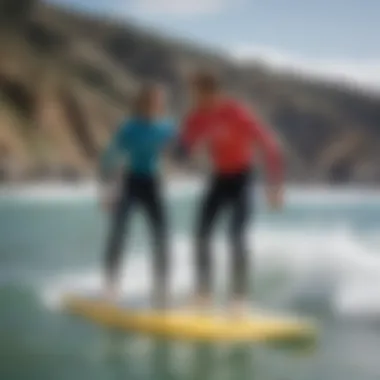
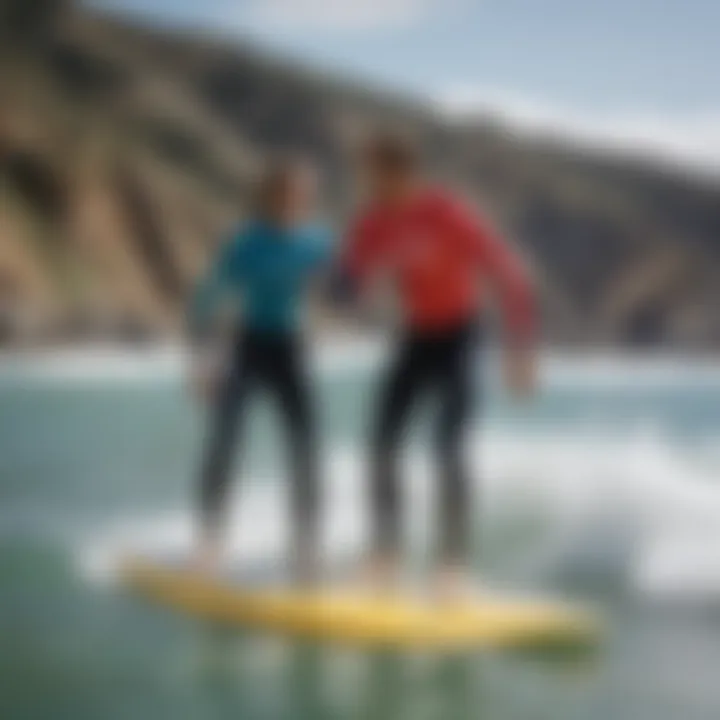
Families can bond through learning and spending quality time in the ocean, creating memories that go a long way beyond just learning to surf. Additionally, instructors are trained to adapt sessions based on individual family dynamics, enhancing the overall experience. The package format allows for flexibility in scheduling and can often include lessons for various skill levels side by side, making it a perfect choice for mixed-ability families.
In summary, the type of surf lesson you choose can significantly influence your learning trajectory and overall enjoyment. By understanding the pros and cons of private, group, and family lessons, you’ll be better equipped to make a decision that suits your specific needs and those of your companions.
Criteria for Selecting the Best Surf School
Choosing the right surf school in Malibu can shape an individual's surfing journey from the first paddle out. For both beginners and more experienced surfers, the criteria employed to select the best surf school cannot be overstated. By focusing on key aspects such as instructor qualifications, student-to-instructor ratios, and safety measures, one can ensure a fulfilling and safe surfing experience.
Instructor Qualifications
When looking for a surf school, the qualifications of the instructors should be a top priority. It’s not simply about their ability to surf; it’s about how well they can teach. An instructor who holds certifications from recognized organizations, like the International Surfing Association (ISA), often showcases their commitment to safety and effective teaching methods. Furthermore, instructors with some level of background in first aid or lifeguarding can provide an added layer of safety during lessons.
Experienced instructors also bring invaluable insights into wave patterns and techniques that can help students accelerate their learning curve. Learning under somebody who has honed their craft over years can make the waves feel less intimidating. Plus, a seasoned teacher can often adapt their instruction style based on the student’s unique needs, making for a more tailored experience.
Student to Instructor Ratio
The student-to-instructor ratio directly impacts the quality of surf instruction. A low ratio means more personalized attention, allowing for quicker feedback and improvement. If a surf school has a high instructor count to student ratio, it can often lead to more effective learning experiences; you’re more likely to find yourself catching waves rather than just listening to instructions from the beach.
For instance, a ratio of one instructor for every three students is generally optimal. It ensures that every student receives focused guidance, reducing the risk of feeling lost in the crowd. Everyone has different learning paces, so a smaller group allows an instructor to focus on individual strengths and weaknesses. In essence, look for schools that prioritize this aspect!
Safety Measures and Equipment
Safety should always be at the forefront of any adventure sport, and surfing is no exception. When selecting a surf school, it’s crucial to inquire about the safety measures they have in place. This includes whether they follow local regulations, if they have lifeguards present, and how the school responds in the case of an emergency.
Additionally, the quality of equipment provided is another significant factor. Ensure that the surf school supplies well-maintained surfboards and wetsuits tailored to fit students of all sizes. Proper gear not only enhances comfort but also boosts confidence in the water. Not to mention, using the right surfboard for your skill level can make a world of difference when it comes to learning.
Ultimately, prioritizing safety, learning from experienced instructors, and ensuring adequate attention through manageable class sizes set the foundation for a memorable surfing experience.
By keeping an eye on these criteria when selecting a surf school in Malibu, each participant can dive into the surfing world equipped and ready to ride the waves.
Highlighting Notable Surf Schools in Malibu
When it comes to surfing, especially in a premier location like Malibu, choosing the right surf school can make all the difference between riding the perfect wave and just treading water. Surf schools not only provide lessons but form communities where surfers, new and seasoned, can share experiences and learn from one another. Highlighting notable surf schools in Malibu is essential in guiding potential surfers towards nurturing their skills in environments that prioritize safety, instruction quality, and enjoyment.
Surfing isn’t merely about mastering balance on a board; it's an immersive experience that blends ocean awareness with technical prowess. Each school offers a unique flavor, catering to different learning styles and preferences.
Some schools may focus on traditional surfing techniques, while others might emphasize modern strategies or eco-conscious practices. This variety allows surfers to find schools that resonate with their own visions of surf culture.
Additionally, the availability of good instructors speaks volumes. They can not only teach the mechanics of surfing but also instill a sense of respect for the ocean. Schools that foster a nurturing environment often see their students flourish, turning newcomers into confident surfers.
Malibu Surf School
Known widely among both locals and visitors, Malibu Surf School has built a reputation as a cornerstone of surfing education in the area. What sets this school apart is its comprehensive approach that merges expert instruction with an emphasis on having fun on the water. Instructors at Malibu Surf School often have a long-standing love for surfing, translating their passion into each lesson they conduct.
Key Features:
- Experienced Instructors: Many are not only qualified professionals but also seasoned surfers themselves.
- Diverse Programs: They offer tailored lessons for various skill levels, from kids to adults, making it inclusive and accessible.
- Safety First: They have robust safety measures, ensuring students feel secure while they learn.
Learn to Surf Malibu
If you're after a personal touch in your surfing journey, Learn to Surf Malibu provides just that. This school emphasizes small class sizes, enabling instructors to dedicate more time to each student. The personalized lesson plans mean that whether you’re a timid beginner or someone looking to refine their techniques, you're in good hands.
Advantages:
- Intimate Learning Environment: With fewer students per instructor, the focus tends to be on individual strengths and weaknesses.
- Flexible Scheduling: They offer various time slots to accommodate different schedules, from early morning sessions to late afternoons.
- Community Vibe: Students often mention a friendly atmosphere that encourages camaraderie among fellow surfers.
Aloha Beach Camp
Aloha Beach Camp isn’t just about surfing; it’s about creating lasting memories and friendships. This family-friendly surf school combines lessons with a camp environment, making it ideal for those looking to immerse themselves fully in surfing culture. Kids and their families have the opportunity to bond over shared experiences while learning the ins and outs of wave riding.
Highlights:
- Family-Centric Programs: Designed to include parents and children in the surf experience together.
- Fun Activities: Beyond surfing, they provide additional activities such as beach games and environmental education, tying surfing to ocean conservation efforts.
- Positive Reviews: Many parents rave about how their children have developed confidence and skills at Aloha Beach Camp.
"Choosing the right surf school not only enhances learning but fosters a lifelong love for the sport."
By highlighting these surf schools in Malibu, prospective surfers can weigh their options and find a teaching style that suits their personal learning preferences. With thoughtful selection, the journey into surfing can become a deeply rewarding adventure.
Lesson Structuring: What to Expect
When diving into surfing lessons, one of the fundamental aspects is lesson structuring. It's not just about jumping on a board and paddling out; there's a method to the madness that can significantly shape your learning curve. Understanding how lessons are structured can help set realistic expectations and maximize the benefits of your time spent in the water. It’s essential for both beginners and seasoned surfers looking to refine their skills.
Initial Assessment and Goals
Before anyone even touches a surfboard, instructors often conduct an initial assessment. This step is like setting the stage for a play; it helps the instructor understand where each student stands in their surfing journey. Expect questions about prior experience, comfort level in the water, and personal goals. For example, a novice might want to learn how to pop up on the board, while an intermediate surfer may aim to perfect their bottom turn.
Here’s what typically happens during this stage:
- Discussion of Experiences: Instructors often chat about your past experiences with the water and surfing. This dialogue helps them tailor lessons to fit your needs.
- Goal Setting: Students outline what they want to achieve, be it catching their first wave or becoming proficient in advanced techniques.
Setting clear goals not only motivates students but also helps instructors devise a focused curriculum.
Fundamental Techniques
Once goals are established, the next phase dives into fundamental techniques. This is where the rubber meets the road. Expect to cover essential skills that form the bedrock of surfing. Techniques often include:
- Paddling: Learning the right body position and stroke is crucial for getting into waves efficiently.
- Pop Up: This is the quintessential move that transforms you from lying down to standing.
- Balance and Stance: A proper stance can make or break a ride. Instructors will often spend a good chunk of time ensuring students adopt the right posture.
These foundational techniques aren’t just taught; they’re practiced repeatedly. The more time spent on these basics, the more confident a surfer becomes in the water.
Wave Riding Strategies
After mastering the basics, the focus shifts to more advanced surf strategies—specifically, wave riding. This is when the magic of surfing truly begins to unfold. Here, students learn how to read the waves and make intelligent choices about when to catch them. Key strategies typically encompass:
- Positioning: Understanding where to sit in relation to breaking waves is vital.
- Timing: It's all about catching the wave at the precise moment. Too early, and you face a wipeout; too late, and the wave will pass you by.
- Turning Techniques: Mastering how to maneuver on the board is crucial for riding waves effectively.
This stage emphasizes practice under guidance, where students can feel what it’s like to carve through the water, embracing both the thrill and the challenges of wave riding.
Equipment Essentials for Beginners
When embarking on the surfing journey, having the right equipment can make or break your experience. The right setup not only ensures safety, but also enhances the learning curve in the water. It's like showing up to a baseball game without a bat; you won't get very far without the proper tools at your disposal. So, what essentials should every beginner consider when diving into the waves of Malibu?
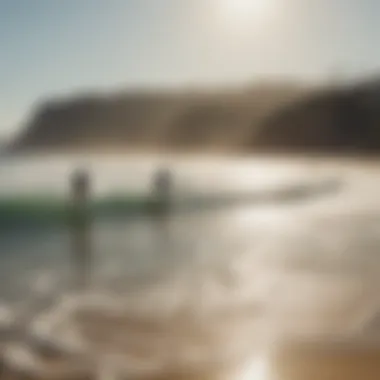
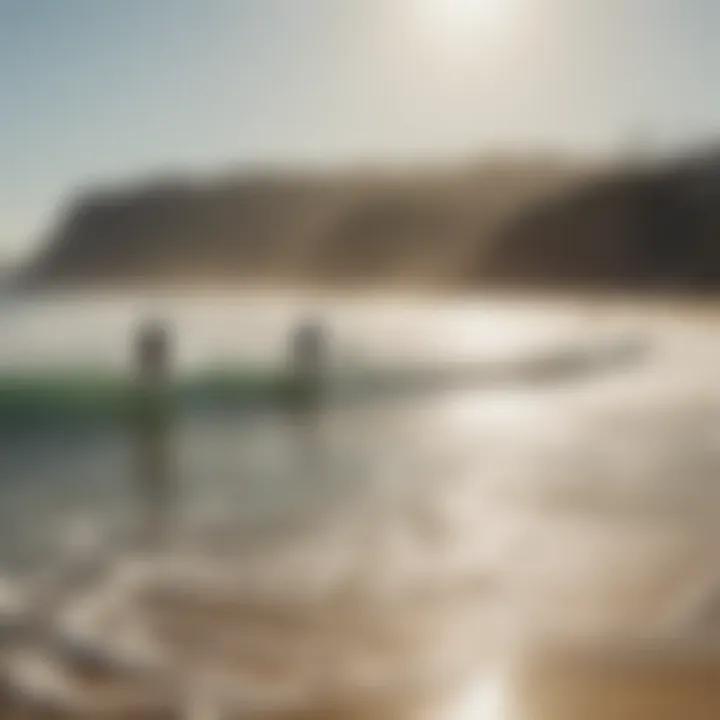
Choosing the Right Surfboard
The surfboard is arguably the most critical component of a new surfer's kit. A first-timer is often overwhelmed by the array of choices available. Generally, boards come in various shapes and sizes, each designed for different surfing styles and conditions. For newbies, a longboard is typically recommended. These boards are wider and offer greater buoyancy, allowing for easier paddling and stability on the waves.
Here are some key considerations when choosing your surfboard:
- Length and Width: Longer boards provide more stability, which is crucial for beginners still getting a feel for balance. A width of 20 inches or more is advisable.
- Volume: Higher volume boards float better, offering you that extra bit of steadiness. Think of volume as the board's ability to support your weight.
- Materials: Surfboards come in various materials including foam, epoxy, and fiberglass. Foam boards provide a soft landing for beginners and are less intimidating.
- Purpose: If you’re enrolling in lessons aimed at catching fun waves on the calmer days, a Malibu-style longboard may be your best bet.
For a deeper dive into surfboard types and their benefits, you might check Wikipedia.
Essential Surf Gear
Beyond the surfboard, having the correct gear can make each outing more enjoyable. It’s not just about hitting the waves; you’ll want to be comfortable and protected. Here’s a breakdown of essential surf gear:
- Wetsuit: Depending on the season, a wetsuit is essential to stay warm in cooler waters. For those chilly morning sessions, a 3/2mm full-suit will keep you toasty without being overly restrictive.
- Leash: This handy piece keeps your surfboard tethered to your ankle, preventing runaway boards. Think of it as your lifeline; you don’t want to have to chase your board down the beach.
- Surf Wax: Applied to the top of your board, this wax provides the grip needed to stay upright. It’s a small yet significant detail that beginners often overlook.
- Sunscreen: Don’t underestimate the sun’s ability to turn your day into a painful experience. Opt for a water-resistant sunscreen to protect your skin from harmful rays while you’re out enjoying the surf.
- Board Bag: A board bag isn’t just for show; it protects your board from dings and damage while transporting it to and from the beach.
Having the right equipment lays the groundwork for a theirt smooth surfing experience, helping you navigate those initial challenging waves while keeping safety at the forefront.
"Invest in your equipment; it’s not just a cost, but an investment in your passion for surfing!"
Understanding these essentials sets the stage for a successful surfing journey. It's where the magic begins, right on the Malibu waves.
Understanding Surfing Safety Practices
Surfing is not just about riding the waves; it's about doing so safely and responsibly. Understanding surfing safety practices is crucial for both beginners and experienced surfers. Safety not only protects the individual but also ensures that the ocean remains a safe environment for everyone. Here, we delve into the significance of safety measures that every surfer should be aware of.
Knowing the Ocean Environment
The ocean is a dynamic entity, constantly changing with the tides, winds, and weather conditions. To surf safely, one must have a solid grasp of the ocean environment. Dive deeper into the following factors:
- Wave Patterns: Recognizing how waves form and break is essential. Whether it’s a beach break or a reef break, different areas have distinct characteristics. Observing these patterns can save you from unexpected wipeouts.
- Rip Currents: These currents can pull you out to sea swiftly. Knowing how to identify rip currents is critical. Look for an area where water appears choppier or murky and always swim parallel to the shore to escape if caught in one.
- Tides: Tidal changes can alter the surf conditions drastically. Understanding whether you are surfing during high or low tide can make a big difference in wave size and the shape of the breaks.
Being knowledgeable about these elements helps surfers make informed decisions, potentially avoiding hazardous situations that could lead to injury.
Signaling for Help
Accidents can happen, even to the most seasoned surfers. That’s why learning how to signal for help is a fundamental safety practice. Here’s how to effectively communicate distress:
- Raise an Arm: If you find yourself in a precarious situation and need assistance, raising one arm overhead, waving back and forth, is a universal signal for help. This gesture should be visible, so ensure you're in a position where lifeguards or other surfers can see you.
- Yell for Assistance: If you're close enough to others, calling for help can also alert someone to your distress. However, conserve your energy when in the water; only shout if you’re certain someone can hear you.
- Stay Calm: Maintaining composure can significantly impact the outcome of an emergency. Panic can cloud judgment and may lead to poor decisions. A clear head is your best asset when facing ocean challenges.
"In the realm of waves, safety shouldn't be an afterthought; it should be your first ride."
By understanding the ocean and knowing how to signal for help, surfers can cultivate a culture of safety that benefits everyone in the water. Embracing these practices promotes not just personal wellbeing but also the wellbeing of the surfing community as a whole.
The Evolution of Surfing Techniques
Surfing has come a long way from its humble beginnings, reflecting changes not just in techniques but also in the culture surrounding the sport. This section addresses how surfing techniques have evolved over the years, adjusting to the needs of both new and seasoned surfers while highlighting that surfing is not merely a sport, but a lifestyle steeped in history and tradition.
Modern surfers often look for performance, speed, and style, which has led to the development of techniques that are distinctively different from traditional methods. Embracing these evolutions not only enhances performance but also broadens the experience of riding waves.
Modern Techniques vs. Traditional Styles
When you compare modern techniques to traditional styles, it's like looking at two sides of a coin. Traditional surfing often emphasized paddling out and positioning for waves, utilizing longboards that encouraged a relaxed, cruising style. In contrast, modern techniques often hinge on maneuverability and responsiveness, aligning with the advent of shortboards.
- More Movement: Today's surfers focus on tighter turns and aerial tricks, utilizing shorter boards made from lighter materials. This allows for greater freedom of movement on the wave.
- Different Shapes: The shapes of surfboards have evolved, providing not only speed but also improved balance and control. Techniques like radical carve turns, aerials, and even the use of fins have transformed how surfers interact with the water.
- Training and Lessons: Modern surfing lessons often integrate video analysis, allowing learners to view their form and make quick adjustments. The old days didn’t have such tech; surfers relied more on intuition and experience.
It's crucial for both instructors and students to appreciate these transitions. Learning modern techniques could significantly alter the trajectory of a novice's journey on the waves.
Impact of Technology on Surfing
Entering this digital age, technology has permeated almost every aspect of surfing, reshaping not just the methods of engagement but also the equipment itself. This transformation carries multiple facets that warrant attention:
- Innovative Equipment: The surfboard revolution has spawned materials like epoxy and carbon fiber, which are lighter and stronger. These advancements make boards easier to maneuver and help surfers achieve higher speeds.
- Wave Prediction Models: Modern surfers can utilize technology to predict wave conditions. Websites and apps dedicated to forecasting oceanic activities help surfers plan their sessions, ensuring they get the most out of their time in the water.
- Safety Developments: Advances in surf safety gear—like inflatable vests and more durable wetsuits—offer greater protection for surfers, especially in larger and more challenging waves.
"Watching this transformation in surfing not only showcases a sport's adaptability but also contributes to making the experience safer and more enjoyable for everyone involved."
As surfing continues to evolve, it’s important for students and instructors alike to stay aware of not just what’s trendy, but what enhances ability and safety. In this constant development, both legacy and future align to create a rich tapestry of surfing techniques that thrust surfers forward while connecting them to their roots.
Community and Culture of Surfing in Malibu
Surfing in Malibu goes far beyond just learning to catch a wave; it encompasses a lifestyle deeply rooted in community and culture. The essence of surfing in this iconic locale lies in the connections made, the shared experiences, and the respect for both the ocean and the surroundings. From local enthusiasts to visitors seeking adventure, the surfing community here welcomes all whether you are a novice or riding the swells for years.
The camaraderie among surfers is palpable. Regulars often greet each other with friendly nods or waves, fostering a sense of belonging. This close-knit atmosphere encourages collaboration and support, with more experienced surfers taking time to share tips or offer guidance to newcomers. In Malibu, it's not just about individual skill but rather how the community uplifts each other to embrace the ocean's thrill.
"Surfing is a shared experience, a bond that extends from the waves to the shore."
Community events, such as beach clean-ups and competitions, bring people together, reinforcing the idea of mutual respect and responsibility towards the environment. When the community bands together to organize local surfing competitions, it doesn't just showcase talent; it also strengthens relationships among participants and spectators alike. These competitions often highlight team spirit, with each member cheering for their peers, creating an energetic blend of excitement and encouragement.
Local Surfing Competitions
Local surfing competitions form an integral part of Malibu’s surfing culture. They provide a platform for surfers to demonstrate their skills and are often characterized by friendly rivalry. These events usually draw a crowd that ranges from family and friends to professional surfers and industry professionals, all eager to engage in the festivity of the sport.
Typically held during peak surfing season, these competitions feature various categories based on age and skill level. Not only do they showcase local talent, but they also attract visitors to the stunning beaches of Malibu. Competitors often take this opportunity to network, share surfing stories, and even discuss the philosophy behind their style. The sense of achievement felt after riding a perfect wave, in front of an encouraging crowd, is priceless, fostering a deeper appreciation for the sport.
Additionally, many competitions are tied to causes that reflect the community's commitment to environmental stewardship. Proceeds from entry fees might benefit ocean conservation efforts or local charities, underscoring that surfing culture here champions not only athleticism but also responsibility to the environment.
Social Responsibility and Eco-Consciousness
As part of the wider community, surfers in Malibu actively embrace social responsibility and eco-consciousness. The ocean is not merely a playground; it’s a vital ecosystem needing care and respect. With years of surf culture and history, there's a deep understanding among local surfers that each wave ridden involves a commitment to conservation.
Surfers often participate in group efforts to clean beaches, removing litter and debris to protect marine life. These conscious initiatives are part of a broader movement within the surfing community across the globe, encouraging cleaner oceans and awareness about environmental degradation.
Some surf schools in the area go a step further by incorporating these principles into their lessons. They teach students about ocean currents, marine ecosystems, and the impact of pollution while instilling respect for nature. Surfing becomes not only a physical activity but also an educational experience, promoting a lifestyle that prioritizes sustainability.
The End
In Malibu, the culture surrounding surfing is inextricably linked to community engagement and social responsibility. Through local competitions and eco-conscious efforts, surfers not only ride the waves but also ride the tide of change, championing causes that protect the oceans. Embracing these values enhances the surfing experience, making it truly transformative for each participant.
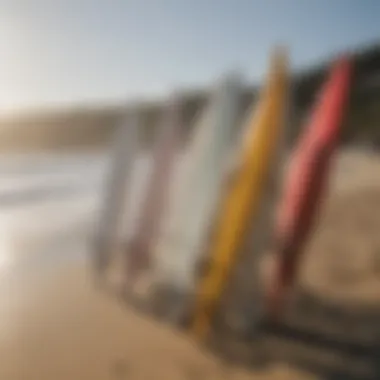
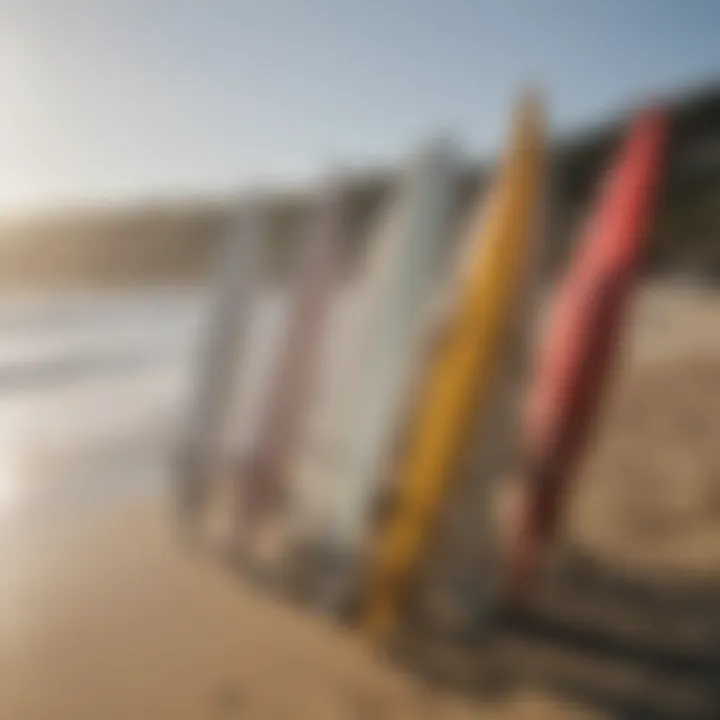
Personal Experiences and Testimonials
When it comes to learning how to surf, personal stories can be a window into the real-world dynamics of surf lessons, particularly in a setting as vibrant as Malibu. They serve not only as anecdotes but also as powerful influencers for potential surfers. Understanding the journey of others—be they beginners or seasoned riders—can illuminate the path for individuals considering taking up the sport.
The value of these narratives cannot be overstated. They bring in aspects like emotional highs and lows, the nuances of learning curves, and sometimes the unexpected challenges that are part and parcel of a surfing journey. By diving into the personal experiences of surfers, we can extract key insights into what makes a good lesson versus a mediocre one.
Benefits of Personal Experiences
- Real-Life Insights: They offer a glimpse into the day-to-day realities of surf lessons. Seeing how others navigated their lessons can clarify expectations.
- Building Community: Sharing experiences fosters a sense of belonging among surfers. It connects beginners with seasoned individuals, cultivating an environment where stories of triumph and struggle are shared openly.
- Learning from Mistakes: Often, it’s not the triumphs that resonate most, but the missteps. Insights gained here can guide novices on what to avoid on their journey.
- Motivation and Encouragement: Hearing about someone who successfully learned to ride a wave can be incredibly inspiring for those hesitant to start.
These testimonials not only highlight the fun aspects but also echo the dedication required to master the waves. Considering the highs and lows captures the essence of what it means to embark on a surfing journey in Malibu.
Beginner Stories
The narratives of beginners can be particularly eye-opening. Many recount their first attempts at balancing on a surfboard, often filled with a mix of excitement and anxiety. For instance, a local surfer might recall her first lesson at Malibu Surf School, where she wrestled with catching her first wave. "It felt like I was trying to ride a tornado!" she remembered, laughing at the memory of her many tumbles. However, through persistent practice and with the guidance of her instructor, she finally stood up on her board, even if just for a fleeting moment. This moment of success ignited her passion.
Another learner might have experienced a starkly different journey—one that involved numerous sessions of paddling out without ever really catching a wave. This individual's story emphasizes the importance of patience and resilience in the learning process. He might stress how vital the role of supportive instructors was in fostering belief amid frustrations. These stories confirm the notion that while the surfing experience can vary significantly, the emotional rollercoaster remains largely the same.
Expert Insights
Moving beyond novices, expert insights offer a treasure trove of wisdom distilled from years spent honing the craft. Each surfer has their unique approach and philosophy towards surfing, which can provide students with valuable guidance. For example, a seasoned surfer may touch on the significance of understanding ocean patterns and local conditions, which often play a pivotal role in riding successfully.
An instructor from Learn to Surf Malibu might share thoughts on how today’s surfers face unique challenges compared to past generations. "We have more access to technologies and resources than ever before, yet the love for the ocean remains unchanged," he pointed out, emphasizing how this balance can sometimes lead to overthinking rather than simply enjoying the ride.
With expert stories intertwined with technical tidbits, learners gain not only inspiration but also practical knowledge that they can readily apply to their lessons.
In summary, from fresh faces to veteran riders, personal experiences and testimonials unveil the reality of surf lessons in Malibu. They enrich the learning environment with their lessons, challenges, and encouragement. Everyone has a unique story that reflects the spirit of surfing—one of adventure, community, and persistent joy amidst the waves.
Future Trends in Surfing Education
Surfing is transforming, and so is the way people are learning this beloved sport. The traditional methods have paved the way for innovative techniques and technologies that cater to a broader audience. This change is crucial for the growth of surfing as a recreational activity and a competitive sport. With the increase in interest from young and old alike, being attuned to emerging educational trends can enhance overall surfing experiences, making lessons not only effective but also enjoyable.
Exploring future trends in surfing education means looking beyond the wave and considering how technology, environmental consciousness, and versatility in teaching methods can shape new generations of surfers. The influx of online courses and a focus on sustainable practices are at the forefront of this evolution, allowing learners from varying backgrounds to engage with the sport on different levels.
"The strides being taken in surf education reflect a larger movement in sports. It’s about accessibility and adaptability, ensuring everyone has the chance to ride that wave."
Online Surf Courses
The digital landscape is changing how we approach learning—and surfing is no exception. Online surf courses are making waves by offering flexible, nearly boundless opportunities to learn. Tailored content can determine the pace at which individuals learn, catering to their specific needs without being tied down to stringent schedules.
Platforms such as Surf Simply and Skillshare provide comprehensive video tutorials, covering everything from basic paddling techniques to advanced maneuvering strategies. These resources allow learners to revisit lessons at their convenience, solidifying skills before hitting the water. Key benefits of online courses include:
- Accessibility to diverse teaching styles: Different instructors each bring unique perspectives and techniques which can enrich learning experiences.
- Cost-effective solutions: Many online platforms offer affordable subscription models, making quality education available at lower price points compared to in-person lessons.
- Blended learning opportunities: A combination of online theoretical lessons and practical in-person sessions can foster deeper understanding, allowing instructors to tailor on-water lessons based on individual progress.
Having this wide array of resources at one’s fingertips is groundbreaking. For those who might not have access to local surf schools or prefer a self-guided approach, online courses mark a turning point in inclusive surf education. However, it's essential to combine this knowledge with actual ocean experience for it to pay off.
Sustainability in Surf Training
With the growing concern around climate change, sustainability is starting to play a pivotal role in surfing education. Today’s surf schools are adapting their curricula to emphasize the importance of caring for coastal environments while teaching surfing skills. This awareness fosters a sense of responsibility in learners while creating a culture of sustainability within the sport.
Older generations of surfers often reminisce about the untouched beauty of the ocean; new surfers have the responsibility to uphold these values. Schools like Aloha Beach Camp showcase eco-friendly practices, teaching students not only about waves but also about the ecosystems they inhabit. Here are ways sustainability is becoming integrated into surf training:
- Conservation Classes: Some surf schools introduce modules on ocean conservation and environmental awareness into their lessons, emphasizing the interconnectedness of surfing and the health of marine life.
- Eco-friendly Surf Gear: Promoting equipment made from sustainable materials empowers surfers to make choices that benefit the environment, such as using boards crafted from recycled materials or biodegradable wax.
- Community Involvement: Encouraging students to participate in local beach clean-ups or advocacy groups reinforces the idea that every surfer plays a part in preserving the ocean for future generations.
Integrating sustainability into surf training transforms a mere sport into a lifestyle choice. With a dual focus on skill acquisition and environmental stewardship, the upcoming trends in surf education show that they are not just teaching individuals to ride waves but to respect the waters they surf upon.
Culmination
In looking back at the rich tapestry of surfing lessons available in Malibu, it’s clear that multiple elements intertwine to make this exploration more than just an ordinary guide. Within this sun-drenched haven, the commitment to craft and community shines brightly.
Firstly, the benefits of engaging in surf lessons can’t be overstated. Surfing here is not merely about catching waves; it’s a gateway to understanding ocean dynamics, enhancing physical fitness, and fostering a profound respect for nature. Lessons are tailored, ensuring that even newbies find their feet—quite literally—while experienced surfers refine their techniques.
Considerations when selecting a surf school are paramount. One must weigh aspects like instructor qualifications and the student-to-instructor ratio. These elements significantly affect the quality of the education received, impacting how quickly one can adapt to the surf environment. Not to mention, safety should always be a foremost thought, especially in bustling surf spots.
The nuances of the surfing techniques discussed throughout the article encourage surfers of every level to aim for not just progress but mastery. Knowing that each wave presents a unique challenge can inspire confidence and curiosity alike.
Moreover, the community fabric of Malibu enhances the learning experience. Local competitions, workshops, and eco-conscious initiatives foster camaraderie among surfers, establishing a culture that extends beyond mere hobby—surfing becomes a lifestyle.
In essence, as surfers embark on this adventure, the lessons learned in Malibu linger well after one steps off the board. It’s about forming connections to both people and nature, underscoring that at its core, surfing embodies freedom and exploration. With the right guidance and a restorative ocean at their feet, anyone drawn to this sport can unlock a world of possibilities, growth, and joy.
"Surfing is not just a sport; it’s a way of life that connects us to the ocean and to each other."
Ultimately, the journey through these surf lessons in Malibu promises more than just developing skills; it cultivates friendships and memories that last, making the pursuit of riding waves an enriching experience where the thrill of adventure never fades.
Additional Resources for Surf Enthusiasts
As any surfing aficionado knows, knowledge is power. For those eager to learn or refine their skills in the waves of Malibu, having access to the right resources can make all the difference. These resources not only offer valuable insights but also serve to build a community among surfers of all levels. Let’s take a closer look at crucial resources that can enhance your surfing journey.
Books and Manuals
Diving into literature focused on surfing grants individuals a solid foundation. Books and manuals offer a wealth of techniques, weather patterns, and ocean behaviors that every surfer should understand. Titles like "Surfing Fundamentals" by Peter Smith or "The Complete Guide to Surfing" provide core knowledge that enriches both novices and seasoned surfers alike.
Benefits of utilizing books include:
- In-Depth Learning: Unlike quick online articles, books often dive deeper, explaining concepts thoroughly.
- Visual Aids: Many include detailed illustrations and photographs that can clarify complex techniques.
- Personal Stories: This element can be particularly inspiring; some authors share their path to mastery, which may resonate with beginners.
Here’s a short list of must-read surf books:
- "The Wave" by Susan Casey
- "Barrel ‘O Fun: A Surfing History of the 1960s and 1970s" by John Whelan
- "Every Day is a Friday: How to Be a Surf Shredder from Dusk Till Dawn" by Amy Escamilla
Make sure to check local libraries or online platforms like Amazon or Goodreads for these titles, as they open up a window into different surfing philosophies and approaches.
Online Forums and Communities
In today’s digital age, online forums and communities serve as bustling hubs for surfers. Sites like Reddit host dedicated threads where surfers exchange tips, reviews, and personal experiences. These platforms create a unique sense of camaraderie where everyone is on a shared journey.
Some advantages of engaging in these online communities are:
- Real-time Advice: Instant responses to questions about gear, local surf conditions, and lessons mean a wealth of knowledge is just a few clicks away.
- Networking Opportunities: Finding surf partners or mentors becomes easier. Many surfers share their experiences, which can be invaluable for learning.
- Evolving Trends: By participating, one can stay updated on the latest techniques, safety practices, and events happening in the surfing world.
Consider joining specific groups on platforms like Facebook or dedicated subreddits on Reddit such as r/surf. There’s a world of wisdom and shared adventures waiting.
"Surfing is more than just a sport; it's a way of life. Connect with like-minded souls to make the journey richer."
In summary, whether you’re picking up a surf manual or engaging in a vibrant online discussion, each resource plays a pivotal role in enhancing one’s surfing experience. The blend of literature and community offers a tapestry of knowledge that is indispensable for any enthusiast eager to ride the waves in Malibu.







